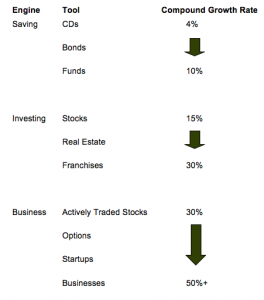 There is a very simple reason why most business owners are not wealthy.
There is a very simple reason why most business owners are not wealthy.
Can’t guess?
I’ll give you a hint: the secret is in this statistic:
According to the US Census Bureau, in 2008 there were 27.3 million businesses in the USA. Of these 21.3 million have no employees.
Think about it, 78% of all businesses in the USA have NO employees.
Now, some of them may be bloggers. Some may be eBayers. Some of them may own niche eCommerce sites. But, I bet that the bulk cut hair, mow lawns, see patients, and so on.
They don’t have employees because they offer a relatively simple service: writing, middle-manning, mowing, cutting, diagnosing …
You get the picture.
They are not wealthy because service businesses are very limited in how much revenue they can generate.
Generally, they are a job – albeit a lucrative job for a lucky few – nothing more. And, if these service business owners don’t put in place a very aggressive savings/investment strategy they will never become wealthy.
Ramit at I Will Teach You To Be Rich tells the story of Mark who quit his high-flying day-trading career and gave away his entire $1 mill. net worth just to prove that getting rich (sic) the first time around was no fluke.
Really!
You should read his story here.
What struck me is how Mark has now created a nice little kitchen table business for himself:
“I was surprised,” Mark recalled. “[by] this little, easy thing that I can do in an hour. [My clients] want me to hacker test their site and give them a logo to put on the bottom of the site when it passes.” Depending on his schedule, Mark contacts about 15 leads a day. He adds the rest to his growing lead database.
Can you see how Mark is building a nice little service business; contacting 15 leads / day, which I guess allows him to service 7 or 8 in a day (if half convert into paying customers, and if it takes him 1 hr to do each, and if he can do all his other biz admin/marketing after hours)?
What can he charge?
If as much as $99 each (I’m guessing, here), that’s still a nice little earner of $700 / $800 per day or $160k per year!
Again, nothing wrong with that, but hardly likely to make him wealthy, unless Mark does one (preferably both) of two things:
1. Save 50% of his $160k pre-tax income and invest in income-producing assets. Remember, Mark has to generate $1.6 million of assets for every $80k of retirement income that he needs. Oh, and he needs to double that number for every 20 years before he intends to retire to account for inflation,
OR
2. He has to Productize His Service.
This simply means converting his low growth service business – that probably can only be sold for a small amount (typically one to two years’ revenue) – into a high growth ‘real’ business that can be sold for a much higher $$$ figure.
How so?
It means taking Mark out of the picture. By that, I don’t mean replacing Mark with somebody else, I mean making Mark’s – or, his replacement’s – labor secondary to the real purpose of the business.
The benefits of doing this are two-fold:
a) Mark can go on vacation, and
b) the business can scale as big as Mark likes.
Let’s take a closer look at how this might work for Mark:
Mark said that his customers “asked for this little, easy thing that I can do in an hour. They want me to hacker test their site and give them a logo to put on the bottom of the site when it passes.”
If this is really the case (and, I’m not sure what is actually involved, but let’s go with it for the sake of this post) then Mark is really selling a product, not a service: the product is the “logo to put on the bottom of the site”.
Verisign, for example, makes hundreds of millions of dollars a year putting logos on the bottom of sites to indicate that they are secure; it sounds like Mark is doing something very similar.
And, that’s what the customer wants: a logo.
Why do they want a logo?
Well, they really want what the logo represents: whether it be for their own peace of mind (e.g. “my site can’t be easily hacked”) or – more likely – for their customers’ peace of mind (e.g. “I can buy from this site, my info seems pretty safe from being hacked”) The service that Mark offers (i.e. to test the site) is simply the means to that end: if the site passes the test, they get the logo.
And, if they get the logo … then they (and/or their clients) get peace of mind.
Since it helps his customers to sell their own products from their own web-sites, Mark should be able to sell this ‘seal of approval’ for $19, $29, $49, $99, maybe more … maybe a LOT more.
In fact, it should be relatively easy for Mark to create a web-site in WordPress to act as the ‘front window’ for his new product-as-service, and do a bit of side-by-side testing (called ‘A/B testing’) to find the optimal price point.
Now, what about all of that “easy thing that [Mark] can do in an hour” stuff?
Well, since his customers are really buying the ‘stamp of approval’, and the work is easy to do, Mark should be able to train just about anybody to do it! Assuming that it can be done remotely, Mark should be able to use freelancer.com or odesk.com to outsource the work offshore. Cost $4/hr.
Mark’s gross margin should be anywhere from 80% – 95%, which is very typical for web-enabled ‘productized service businesses’ (more commonly known in the software world as Software as a Service or SaaS).
Now that Mark has a high gross margin SaaS business on his hands, he should switch his role to marketing and scaling it using the methods that every other successful SaaS business uses.
No more finding/chasing individual leads and personally delivering services in one hour increments … and, Mark may eventually find that he has a multi-million dollar web-business on his hands.
No fluke, after all. 
 Last week I wrote about joint ventures (JV’s) in real-estate; personally, I don’t like ’em but I showed you the right way and wrong way to enter into one. You should also read the comments.
Last week I wrote about joint ventures (JV’s) in real-estate; personally, I don’t like ’em but I showed you the right way and wrong way to enter into one. You should also read the comments.








